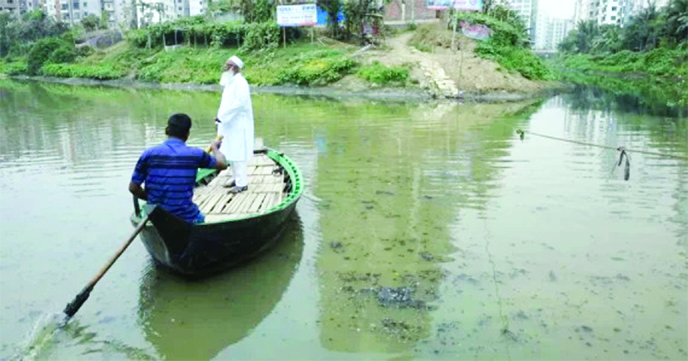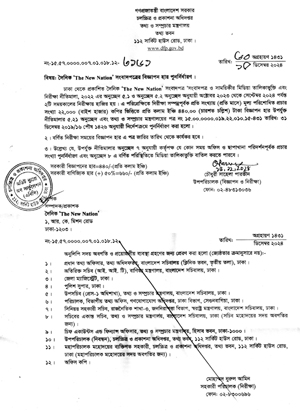City Desk :
A broad road stretches east from the bustling Rampura Bridge in Dhaka, passing between the bridge and the TV Centre, heading towards Trimohini.
On the left-hand footpath, pedestrians are hit by an overpowering stench. The reason: a municipal garbage dumping ground managed by the city corporation. Pressing forward with nose and mouth covered, one is met by the sight of a dead river-its banks barricaded by concrete railings, overgrown with various trees and shrubs, reports UNB.
This so-called river resembles a narrow canal, barely noticeable as a water body.
A small signboard labels it the “Narai River”-a name that might surprise passers-by, who would likely mistake it for a mere drainage ditch.
The road runs alongside the river, with Banasree on one side and Aftabnagar on the other.
Further along the pavement, near the edge of Banasree Block B, another open dumping ground is clearly visible.
Household waste is being deposited here by city corporation staff before being collected by garbage trucks. On the morning of 6 April, a walk of approximately a mile along the riverbank-from Rampura Bridge to Meradia Bazaar-revealed three separate dumping grounds.
The entire riverbank is choked with garbage, in some spots even being burnt in open fires.
Investigations on-site revealed that a multi-storey condominium is under construction near Banasree Ideal School.
Bags of sand and bricks from the site are being dumped by the river.
A little further ahead, in front of Farazi Hospital, ambulances are parked by encroaching onto the river itself.
In the Meradia Haat area, the riverbank has been overtaken by makeshift shops and yet another garbage dumping ground.
Waste is being dumped in open areas along the river, causing unbearable suffering for nearby residents. While the Banasree side has become an open dumping ground, the opposite bank-Aftabnagar-has seen the rise of towering apartment buildings and hospitals.
Some of these structures intrude into the river itself. Even pavement construction under the name of road expansion has eaten away at the river’s land.
In Banasree’s Block C, local resident Ruhul commented, “All the waste from Banasree and Aftabnagar ends up in this river. Open dumping causes immense suffering-we can’t even breathe properly due to the stench.”
A short distance further, Aftabnagar resident Sifatul Islam (43) shared a personal account.
Growing emotional, he recalled his memories with the river. “Back in 1991, I used to travel from Aftabnagar to attend classes at Banasree Ideal by boat.
It took about half an hour. At the time, the entire area of Banasree and Aftabnagar was covered by the flowing Narai River, a branch of the Shitalakkhya. We even had a private boat-like how people now own private cars.”
Standing in Banasree Block F, Sifat-now working at a private university-reminisced, “Encroachment began during the regime of military ruler Hussain Muhammad Ershad. Areas were filled with sand, and we used to play football and cricket on the reclaimed land. Eventually, all of Banasree and Aftabnagar was filled in and high-rises were built.”
He added, “We would travel to Meradia Haat by boat, which was set up on a small earthen mound. We used to buy fishing gear from there.”
Now, he said, “We call it ‘Gandharaj Khal’ (Stinky Canal) because the smell is unbearable. Wastewater from Gulshan and Banani is discharged into this canal. The water has turned pitch-black like tar.”
Sharif Jamil, former General Secretary of Bangladesh Poribesh Andolon (BAPA), claimed the death of the Narai River is a result of a lack of coordinated action.
“Narai was originally connected to Hatirjheel. The construction of the Rampura Bridge was the first step in severing this connection. Over time, both Banasree and Aftabnagar suffocated the river into a mere canal,” he said.
Jamil explained, “If even the remaining part of the river had been preserved, it could have been saved to some extent. Waste from Hatirjheel is supposed to be treated at the Dasherkandi Sewage Treatment Plant. Had this been built earlier, perhaps the river would not have been lost.
However, the treatment facility does not cover all canals. Even after treatment, polluted water continues to flow into Trimohini.”



